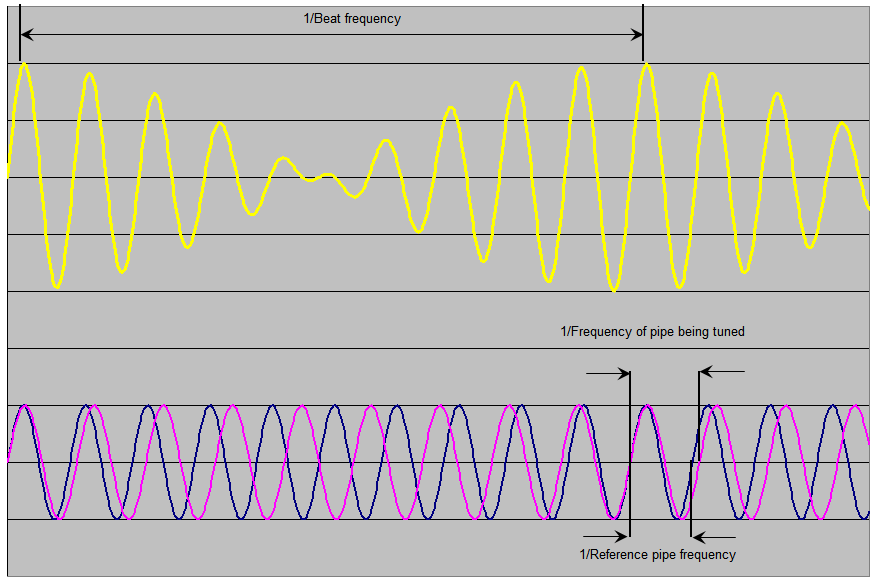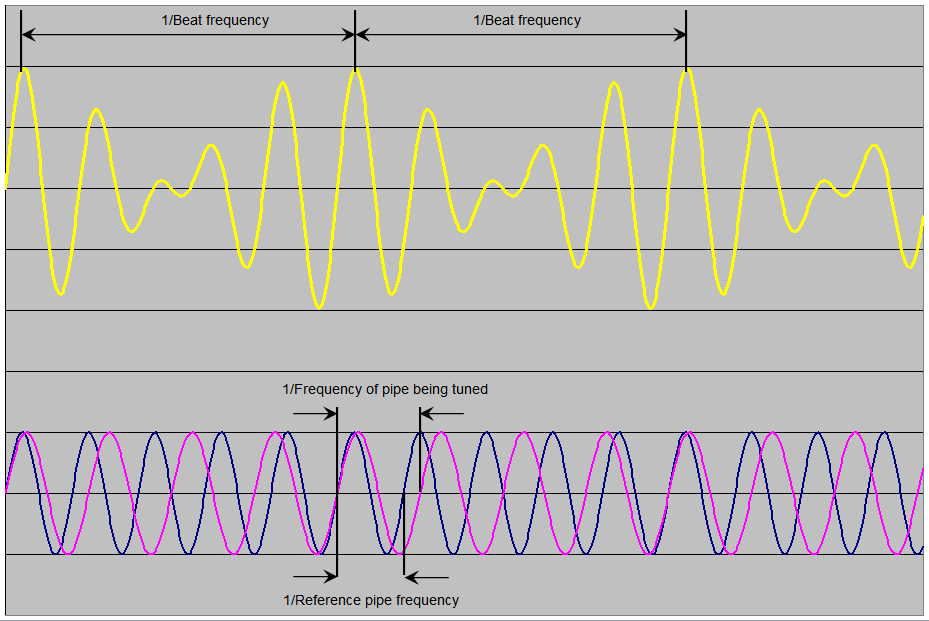Like all musical instruments, organs need to play at the right pitch. The current standard, established in the mid 1920’s, is A = 440 cycles per second (Hertz) . However, every pipe on the organ needs tuning, and with upwards of 600 pipes even on a medium-sized extension organ it is no small job to get this right. It is outside the scope of this page to explain how tuning is accomplished in detail, but some of the questions and answers below may be informative.
Why do we need to tune an organ?
First of all, to ensure that it plays at the correct pitch so that it can be used with other instruments. Secondly, the intervals between the notes need to be correct (see Temperament). On theatre organs with tuned percussions (Chrysoglott, Glockenspiel etc.) it is also important that the pipes are in tune with the percussions.
How are flue pipes tuned?
Flue pipes are tuned by means of the tuning slide (open pipes) or the stopper (stopped pipes). The slide or stopper is moved upwards to deepen the note and downwards to raise the note.
How are reed pipes tuned?
Primarily by moving the tuning wire upwards, to lengthen the free length of the reed and thus deepen the note, or downwards to shorten the free length of the reed and raise the note. However the sound production in reed pipes is a function of both the reed length and the resonator length (the two act as a coupled system); changing one without compensating the other may disturb the regulation of the pipe. For that reason, sometimes the regulating scroll or slide on the resonator may also have to be adjusted. Tuning reeds therefore requires more expertise than tuning flues. If in doubt, leave well alone!
How does the tuner know when the pipe is in tune?
The tuner may use a tuning fork or pitch pipe to set the initial pitch on one pipe of one stop. The chosen stop should be stable in speech. Working from this reference note, the tuner then sets the pitch of the pipes in the surrounding octave by playing each pipe with the reference note, in sequential intervals of fourths and fifths, until the 12 notes of the octave are in tune. This technique is known as the ‘cycle of fifths’ and capitlises on the phenomenon of beating, whereby a pure fifth interval creates no interference beats. To ensure that the 12 notes of the scale are correctly tempered, in fact the tuner will slightly flatten the fifth interval and sharpen the fourth. Once the reference octave is set (sometimes more than one octave is set for accuracy) then the rest of the stop is tuned in octaves. The whole process is known as ‘laying the bearings’. The tuning is then transferred to the other stops, again by playing notes against each other and listening for interference beats. The notion that one needs a musical ear for tuning is not really the case; what is actually needed is an ability to listen and analyse.
How often is it necessary to tune an organ?
The pitch produced by a pipe is dependent on a number of other factors besides length of the pipe or the reed. Absolute temperature affects the density of the air and thus the frequency a flue pipe speaks at. Changes in temperature may cause the reed and tuning wire on a reed pipe to expand or contract, and not return to exactly the same place, thus disturbing the tuning. The skill with which the reed has been made and voiced has an influence on this, as well as the stability of the temperature at which the organ is maintained. When an organ is newly installed it may take some time – months or even years – for the organ to stabilise mechanically, and over this period more frequent tuning may be needed. Once the organ has stabilised, the frequency of tuning should be reduced. Ideally an organ should be tuned as little as possible, completely perhaps only once or twice per year, with some intermediate ‘touching up’ of reeds and other sensitive stops. Very large cathedral instruments may only be tuned throughout annually, a process which can take some days. The business of tuning includes attention to regulation and should be seen as an essential part of the overall management of the instrument. Keeping an organ in tune is all about stability; as in so many areas, less is more and the less an instrument is disturbed the more stable it will be.
What temperature should an organ be tuned at?
Tuned percussions on theatre organs are tuned at the factory. Whilst they need not be absolutely perfectly in tune with the instrument, a flat chrysoglott or glockenspiel can sound very discordant and sour. Because tuned percussion tuning does not vary greatly with temperature (as it is a function of the mass and stiffness of the bars) but flue pipes go sharp as the wind temperature rises, tuning temperature is important. Practice has shown that most theatre organs seem to sound best when tuned and kept at a temperature in the mid-70s Fahrenheit (23 to 25 Celsius), probably a rather high temperature for most unenclosed classical instruments.
What about electronic tuning devices?
Electronic tuning devices are the satellite navigation systems of the organ world. They are very useful for the less skilled but no substitute for the real thing. They are useful for setting pitch and for setting the intervals of the scale, but once this is done the rest of the pipework can be set by means of listening for interference beats.
How does tuning by interference beats work?
Mention has been made of the use of the interference beats to tune pipes. This very simply natural effect allow a tuner to tune one pipe to another to accuracies that would otherwise involve sophisticated electronic apparatus, simply by using the ear.
Diagram 1 below shows the sound waves of two pipes; in this example the black wave form shows the reference pipe to which the other pipe is going to be tuned, and the purple wave form the pipe which is being tuned. As can be seen, the distance between the waves is greater for the pipe that is being tuned; wavelength is the inverse of frequency, so the pipe being tuned is flatter than the reference pipe (lower frequency).
The yellow wave form shows the result of adding the black and purple waveforms; acoustically, sounding two pipes together does not result in a doubling of loudness, but a phenomenon occurs whereby the loudness (‘amplitude”) of the combined sound is reinforced and weakened as the two sound waves coincide and oppose each other. The amplitude of the yellow wave form has a frequency of its own and is detected by the ear as a ‘beating’, or periodic variation in the loudness of the sound.
Diagram 2 below depicts the same situation as above, but the pipe being tuned (purple waveform) has been brought closer to the reference frequency as the pipe is tuned. The amplitude of the resultant waveform (yellow waveform) has increased its wavelength, so the frequency of the beats has slowed down. As the pipe is progressively tuned closer to the reference, so the interference beat slows down until it stops, at which point both pipes are exactly in tune.

Mathematically, the beat frequency is the difference between the two frequencies, so if a pipe is being tuned to a reference pitch of 440 Hertz, but is sounding 441 Hertz, then the beat frequency is 1 Hertz, or one beat per second – easy to hear by the human ear, but already accurate to 0.25%.
The same principle is also used for 32′ Acoustic (or ‘Resultant’) Bass stops. These stops produce a synthetic bass by playing together the note an octave above and the note a fifth above that. The difference in frequencies is heard as a beat frequency an octave lower.

